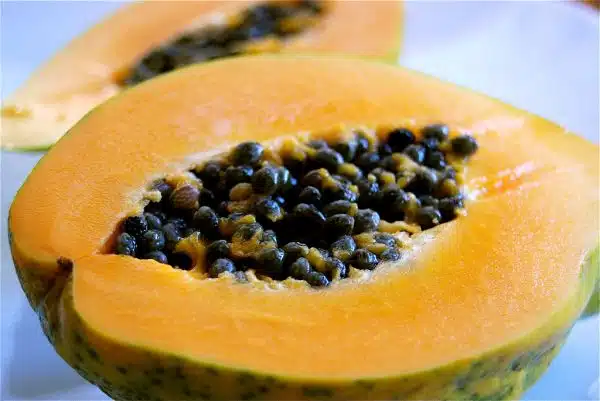Papaya, the fruit of the Carica papaya plant, is known for its sweet flavor and numerous health benefits. But did you know that this tropical fruit can also be grown as an indoor plant? With proper care and attention, papaya plants can thrive in indoor environments, providing a unique addition to any home or office.
As a papaya plant care expert, I have seen firsthand the joy that comes with successfully growing these plants indoors. From choosing the right soil to monitoring water levels and temperature, there are several important factors to consider when caring for a papaya plant. In this article, we will explore everything you need to know about growing and caring for papayas as indoor plants, including tips on lighting, fertilization, pruning, and more. Whether you are a seasoned gardener or just starting out with houseplants, this guide will provide valuable insights on how to care for your papaya plant and enjoy its delicious fruits all year round.
Benefits Of Growing Papaya Indoors
Growing papaya indoors offers numerous health benefits and allows individuals to enjoy fresh, organic fruit year-round. One of the most significant advantages of growing papaya indoors is that it eliminates the risk of exposure to harmful pesticides and other chemicals commonly used in commercial farming practices. This makes indoor-grown papayas a healthier alternative for consumers who prioritize their well-being.
Additionally, growing papaya indoors provides individuals with an opportunity to experiment with various creative recipes. Papayas are versatile fruits that can be used in a wide range of dishes, including smoothies, salads, and desserts. By growing their own indoor papaya plant, individuals have access to fresh fruit that can be incorporated into their meals in innovative ways.
Furthermore, indoor papaya plants require minimal maintenance and can thrive in a variety of environments. With proper care, these plants can produce bountiful yields of juicy and flavorful fruit throughout the year. Therefore, by growing papayas indoors, individuals can reap the benefits of fresh fruit while also adding a touch of greenery to their living spaces. In the following section, we will discuss how to choose the right type of papaya plant for your indoor garden.
Choosing The Right Papaya Plant Variety
Choosing the right papaya plant variety is crucial if you want to grow healthy and fruitful indoor papayas. With so many varieties to choose from, it can be overwhelming to select the perfect one for your needs. However, selecting the ideal variety is not rocket science as long as you have some basic knowledge about papaya plant propagation and comparison of different varieties.
When choosing a papaya plant variety, consider factors such as fruit size, taste, and yield potential. Some of the most popular papaya varieties include the Red Lady, Maradol, Tainung 1, and Solo Sunrise. These varieties have unique features that make them ideal for specific growing conditions. For instance, Red Lady is an early maturing variety that produces sweet and delicious fruits within seven months of planting.
Another factor to consider when selecting a papaya plant variety is its resistance to pests and diseases. The Tainung 1 variety is known for its high resistance against diseases like powdery mildew and phytophthora. On the other hand, Maradol has a low pest resistance but produces large-sized fruits that are great for making jams or smoothies.
In conclusion, choosing the right papaya plant variety can significantly impact your indoor gardening success. By considering factors such as fruit size, taste, yield potential, pest resistance, and disease tolerance before making a selection will ensure that you get the best results from your efforts in growing indoor papayas. Next step? Selecting the ideal pot and soil for optimal growth!
Selecting The Ideal Pot And Soil
- When selecting the ideal pot for a papaya plant, it is important to consider the size, shape and material of the pot.
- Potting soil for papaya plants should be well-draining and nutrient-rich, so a soil blend of organic matter, such as compost, is recommended.
- The pot should have adequate drainage holes to ensure that excess water can flow freely and that the soil does not become waterlogged.
- Clay pots are often used as they are more porous than plastic and allow the roots to breath easier.
- Planting papayas in soil mixes that contain a combination of perlite, vermiculite, and peat moss is recommended as these materials provide good aeration, drainage and nutrient retention.
- When selecting the ideal pot for a papaya plant, it is important to consider the drainage capacity of the pot and the soil chosen.
Choosing The Right Pot
When it comes to indoor papaya plant care, choosing the right pot is an essential aspect of nurturing a healthy and thriving plant. The ideal pot size should be chosen based on the size of the papaya tree, ensuring that there is enough space for its roots to grow. However, it’s important to note that too much space can lead to overwatering and ultimately harm your plant’s growth. As a papaya plant care expert, I recommend selecting a pot that is 2-4 inches larger in diameter than the current pot.
Aside from size, decorative pot options are also worth considering when selecting the ideal pot for your indoor papaya plant. A decorative pot not only adds aesthetic value but can also provide added functionality such as drainage holes or built-in saucers. When choosing a decorative pot, ensure it has adequate drainage holes that allow excess water to flow out easily. If you opt for a pot without drainage holes, consider adding gravel at the bottom of the container to prevent waterlogging.
Ultimately, selecting the ideal pot for your indoor papaya plant requires careful consideration of both practicality and aesthetics. Choose a well-sized container with proper drainage and consider incorporating decorative elements that complement your home’s decor while keeping in mind that what matters most is providing an environment where your papaya can thrive.
Types Of Soil
As a papaya plant care expert, selecting the ideal pot and soil is crucial in ensuring that your indoor plant thrives. In addition to choosing the right pot size and style, the type of soil you use plays a critical role in promoting healthy growth. When it comes to selecting soil for your papaya plant, it’s important to consider its nutrient requirements, pH levels, and drainage capabilities.
The best soil for growing papaya plants should be well-draining yet retain enough moisture to keep roots hydrated. A mixture of organic compost and sand or perlite can help achieve this balance. It’s also important to ensure that the soil has a pH level between 6.0 and 6.5, which is slightly acidic. This helps optimize nutrient absorption and minimize the risk of fungal diseases. Additionally, incorporating the best fertilizers like potassium-rich fertilizers can enhance fruit production.
In conclusion, selecting the ideal pot and soil is essential in nurturing a healthy indoor papaya plant. By choosing a container with proper drainage and incorporating a well-balanced mixture of organic compost and sand or perlite as soil, you are providing an environment where your plant can thrive. Ensuring that your soil has the appropriate pH levels while using the best fertilizers will also promote optimal growth and fruit production for your beloved papaya plant.
Drainage Considerations
To ensure that your indoor papaya plant thrives, selecting the ideal pot and soil is critical. One of the most important factors to consider in soil selection is drainage maintenance. Proper drainage ensures that excess water does not accumulate in the soil, which can lead to root rot and other fungal diseases. To achieve this, it’s recommended to use a well-draining soil mix that contains amendments like sand or perlite. These materials help improve the overall structure of the soil, ensuring that it can hold moisture while still allowing for proper drainage.
In addition to using a well-draining soil mix, it’s also crucial to maintain proper drainage within your chosen pot. This means ensuring that there are enough drainage holes at the bottom of your container and using a saucer to catch any excess water. Additionally, regular maintenance such as removing any debris or dead leaves from the topsoil and periodically flushing out excess salts can help promote healthy drainage.
Proper drainage is essential in promoting healthy growth for papaya plants. By selecting a well-draining soil mix with appropriate amendments and maintaining proper drainage within your chosen pot, you can create an optimal environment for your plant to thrive. Incorporating regular maintenance practices such as removing debris and flushing out excess salts can further enhance your plant’s overall health and growth potential.
Understanding Papaya Plant Watering Needs
After selecting the ideal pot and soil for your papaya plant, it is crucial to understand its watering needs. Overwatering or underwatering can lead to stunted growth, root rot, and even death of the plant. Papaya plants require frequent watering, but not in excess. The frequency of watering depends on various factors such as temperature, humidity, and soil drainage.
The best way to determine when to water your papaya plant is by checking the top inch of soil. If it feels dry to the touch, it’s time to water. However, if the soil is still wet, hold off on watering until it dries out. Papaya plants do not like sitting in standing water; hence proper drainage is essential. Signs of overwatering include yellowing leaves and wilting stems.
Proper watering also involves maintaining a consistent schedule for your papaya plant. During hot summer months when temperatures rise above 85°F (29°C), increase watering frequency as needed. On the other hand, during winter or cooler temperatures below 60°F (15°C), reduce watering frequency since the plant goes into a dormant phase. By following these guidelines and observing your papaya plant’s response, you can maintain proper hydration levels for healthy growth and fruit production.
Transition: While understanding papaya plant’s watering needs is important for optimal growth and health, managing temperature and humidity levels are equally crucial in ensuring their well-being.
Managing Papaya Plant Temperature And Humidity
Temperature control is important for optimal growth of papaya plants, as they thrive in temperatures between 65-85 degrees Fahrenheit. Humidity control is equally important, as papaya plants need 50-70 percent relative humidity. In order to maintain these conditions, a combination of natural and artificial methods may be used, such as ensuring proper ventilation and providing adequate shade. Additionally, regular misting of the plant can help to maintain the desired humidity levels.
Temperature Control
Ensuring that papaya plants are grown under ideal growing conditions is crucial for their healthy growth and development. Temperature regulation is one factor that contributes significantly to the overall well-being of the plant. As an indoor plant care expert, I recommend maintaining a temperature range of 65-75°F (18-24°C) during the day and slightly cooler temperatures at night. Papaya plants thrive in warm and humid environments, so it’s essential to keep them away from drafty windows or doors that could cause fluctuations in temperature.
During winter months, it’s crucial to provide extra warmth to your papaya plant by placing a heating pad or grow light near the plant. This will help maintain an optimal temperature range and ensure that the plant doesn’t become too cold. Conversely, during summer months, it’s essential to keep the papaya plant out of direct sunlight as this can cause overheating and damage to the leaves.
In conclusion, temperature regulation is an important aspect of managing papaya plant temperature and humidity. Paying close attention to the ideal growing conditions will ensure that your papaya plants thrive and remain healthy throughout their lifespan. By following these tips, you’ll be able to enjoy a beautiful and lush indoor garden filled with healthy papaya plants!
Humidity Control
Maintaining an optimal level of humidity is another crucial aspect of managing papaya plant temperature and humidity. Papaya plants prefer a high level of humidity, ranging from 60% to 80%, that mimics their natural tropical habitat. A lack of moisture in the air can cause the leaves to droop or even turn brown, while excess moisture can lead to fungal growth and other issues. Therefore, it’s essential to keep the humidity level in check.
One way to regulate humidity levels is by investing in a dehumidifier, which will remove excess moisture from the air. This equipment is particularly useful during humid summer months when the air becomes too moist for the plant’s liking. Alternatively, there are several DIY methods that one can employ such as placing a tray of water near the plant or misting its leaves regularly. These methods help maintain an adequate level of moisture around the plant without causing any harm.
In conclusion, managing papaya plant temperature and humidity requires careful attention and monitoring. Maintaining an optimal temperature range and ensuring appropriate levels of humidity will provide your papaya plants with ideal growing conditions. By employing dehumidifier recommendations or DIY methods for controlling humidity levels, you’ll be able to create a comfortable environment for your plants that promote healthy growth and development.
Providing Adequate Lighting For Papaya Plants
As the saying goes, “light is life”. This holds true for indoor papaya plants as well. Adequate lighting is essential for these tropical plants to thrive and produce fruit. In this section, we will discuss some papaya plant lighting tips and the indoor papaya plant light requirements.
Firstly, it is important to note that papaya plants require bright, indirect sunlight for at least 6 hours a day. Direct sunlight can scorch the leaves and cause damage to the plant. If your home does not receive enough natural light, you can supplement it with artificial lighting. LED grow lights are a great option as they provide a full spectrum of light that mimics natural sunlight and can be adjusted to meet the needs of your specific plant.
Secondly, it is crucial to ensure that your papaya plant receives consistent lighting. Fluctuations in light can cause stress to the plant, leading to stunted growth and decreased fruit production. To maintain consistency, consider using a timer for your grow lights or placing your plant near a window that receives consistent sunlight throughout the day.
Lastly, keep in mind that as your papaya plant grows, its light requirements may change. Be sure to monitor its growth regularly and adjust its lighting accordingly. By providing adequate lighting to your indoor papaya plant, you are setting it up for success and ensuring delicious fruit for years to come.
Now that we have covered how to provide adequate lighting for your indoor papaya plant let’s move on to fertilization techniques for optimal growth and fruit production.
Fertilization Techniques For Papaya Plants
When it comes to fertilizing papaya plants, there are two main options: organic fertilizers and synthetic fertilizers. Organic fertilizers are derived from natural sources such as compost, manure, or bone meal. These types of fertilizers provide a slow-release source of nutrients that can help promote healthy growth in papaya plants. However, they may not provide all the necessary nutrients in the correct balance.
On the other hand, synthetic fertilizers are made from chemical compounds and provide a quick-release source of nutrients to your papaya plant. They can be very effective but must be used carefully to avoid over-fertilization, which can damage your plant’s roots and even kill it. Additionally, synthetic fertilizers can negatively impact the environment if used excessively.
It is important to note that both organic and synthetic fertilizers have their pros and cons. Ultimately, choosing the right one for your papaya plant depends on various factors such as soil type, climate conditions, and the overall health of your plant. Consulting with a professional gardener or horticulturist can also be helpful in determining the right fertilizer for your specific needs. In the next section, we will discuss how pruning papaya plants can further optimize their growth potential.
Pruning Papaya Plants For Optimal Growth
As the saying goes, “prune to bloom.” Regular pruning is an essential aspect of maintaining the health and productivity of your papaya plants. Proper pruning techniques can help optimize fruit production while also preventing overcrowding and disease. In this section, we will discuss papaya plant pruning techniques and the benefits of regular pruning.
Before we delve into the specifics of papaya plant pruning, it’s important to understand why it’s necessary. Papaya plants grow fast and can quickly become too tall or bushy, leading to overcrowding and decreased fruit yield. Pruning helps maintain a balanced shape, promotes healthy growth, and improves air circulation around the plant.
There are two main types of papaya plant pruning: tip-pruning and structural-pruning. Tip-pruning involves removing the growing tips of branches to encourage lateral growth and prevent excessive height. Structural-pruning involves removing entire branches or stems to maintain a balanced shape and remove any diseased or damaged parts. By regularly practicing these techniques, you can ensure that your papaya plants are healthy, productive, and aesthetically pleasing.
| Pruning Type | Benefits | Tools Needed |
|---|---|---|
| Tip-Pruning | Encourages lateral growth; prevents excessive height | Pruning shears |
| Structural-Pruning | Maintains balanced shape; removes diseased or damaged parts | Pruning saw/loppers |
Incorporating regular pruning into your papaya plant care routine has numerous benefits beyond improved fruit yield. It can prevent overcrowding which leads to pest infestation and disease development by improving airflow around the plant. Furthermore, it allows for better sunlight penetration into lower branches which will also result in optimal photosynthesis leading to more fruitful crop yields.
Now that we have discussed the importance of proper papaya plant pruning techniques let us move on to our next topic: preventing and treating common papaya plant pests and diseases.
Preventing And Treating Common Papaya Plant Pests And Diseases
Preventing and treating common papaya plant pests and diseases is crucial for maintaining the health and productivity of your indoor papaya plant. The first step in pest management is to identify the type of pest or disease affecting your plant. Common pests that infest papaya plants include spider mites, mealybugs, and aphids. Diseases such as powdery mildew, black spot, and leaf spot can also cause damage to your plant.
One effective way to prevent pests and diseases from attacking your papaya plant is by providing optimal growing conditions. Ensure that your plant receives adequate sunlight, water, and nutrients. Avoid overwatering or allowing water to accumulate around the base of the plant as this can lead to bacterial or fungal growth.
In case you observe any signs of pests or diseases on your papaya plant, it’s advisable to first try natural remedies before resorting to chemical pesticides. Natural remedies such as neem oil, garlic spray, or a solution of dish soap and water can be effective in controlling pests. For fungal infections such as powdery mildew, spraying a mixture of baking soda and water can help prevent further spread. However, if the infestation persists or becomes severe despite using natural remedies, consult with a professional for appropriate treatment options.
As you now know how to identify common pests and diseases that affect papaya plants, it’s important to take necessary measures in preventing and treating them. By following proper growing practices and utilizing natural remedies when possible, you can maintain a healthy indoor papaya plant that produces delicious fruits. In the next section, we will learn about harvesting ripe papayas for optimal flavor and texture.
Harvesting Papaya Fruits
Papaya fruit ripening is a crucial factor to consider when harvesting the fruits. The fruits should be picked when they are fully ripe, which is indicated by the yellow color on the skin, and they should easily detach from the stem with a gentle twist. If left on the plant for too long, papayas can become overripe and may even split open.
Proper spacing of papaya plants is essential for optimal fruit production and easy harvesting. The distance between plants should be at least 8-10 feet apart to allow enough space for each plant to grow and develop without competing with each other. Adequate spacing also ensures proper airflow, prevents overcrowding, and promotes healthy foliage growth.
Ensuring that you harvest your papaya fruits at the right time and plant them in proper spacing will guarantee a bountiful yield. Remember to handle harvested papayas gently as they bruise easily and can quickly spoil if not handled with care. In our next section, we’ll explore how to store and prepare papaya fruits after harvesting them from your indoor garden.
Storing And Preparing Papaya Fruits
When it comes to papaya fruits, proper storage is crucial in maintaining their quality and freshness. Papayas are tropical fruits that are highly perishable, and improper handling can lead to spoilage or loss of flavor. To ensure the best taste and texture, it’s important to follow some simple tips for storing and preparing papaya fruits.
One way to store papayas is by keeping them at room temperature until they ripen. Once fully ripe, they can be stored in the refrigerator for a few days. However, if you want to prolong their shelf life even further, you can freeze them. Simply cut the papaya into chunks or cubes, place them in an airtight container or freezer bag, and store in the freezer for up to 6 months.
If you’re looking for ways to use your papaya fruit beyond eating it plain, there are many delicious recipes that incorporate this tropical fruit. From smoothies and salads to salsas and desserts, there are endless possibilities when it comes to cooking with papayas. Some popular recipes include Papaya Coconut Smoothie, Papaya Salad with Lime Vinaigrette, Grilled Fish Tacos with Papaya Salsa, and Papaya Sorbet. With so many options available, you’re sure to find a recipe that suits your taste buds.
Transitioning into the subsequent section about propagating papaya plants: Now that you know how to store and prepare your papaya fruits properly, it’s time to learn about propagating your own plants at home. By following some basic steps for propagation and care, you can grow your own healthy papayas right from your own backyard.
Propagating Papaya Plants
- Propagating papaya plants from seeds is a relatively straightforward process that can be used to create new plants from existing ones.
- To propagate from seeds, the outer flesh of a papaya fruit should be removed and the seeds should be dried before planting.
- Propagating papaya plants from cuttings is a more labor-intensive but still effective method for replicating existing plants.
- To propagate from cuttings, a healthy stem of an existing papaya plant should be cut off and allowed to root in moist soil.
Propagating From Seeds
If you’re looking to propagate papaya plants, one way to do it is by starting from seeds. The germination process for papaya seeds can take anywhere from two to four weeks, and it’s important to keep the soil moist during this time. Once the seedlings have emerged, make sure they receive plenty of sunlight and warmth.
Seedling care is crucial for the success of your papaya plants. When the seedlings have grown their first set of true leaves, you can transplant them into individual pots with well-draining soil. Keep the soil moist but not too wet, and provide them with enough light and warmth. Papaya plants thrive in temperatures between 68-86°F (20-30°C), so make sure they are not exposed to cold drafts or extreme heat.
It’s important to note that papaya plants grown from seeds may not produce fruit that is true to its parent plant. This is because papayas are cross-pollinated by insects, which can result in genetic variations in the fruit. However, if you’re simply looking to grow a healthy indoor plant, propagating from seeds is a great option that can be rewarding and fun!
Propagating From Cuttings
To propagate papaya plants, there are various methods to choose from. While starting from seeds is a popular option, propagating from cuttings is another route that can lead to success. If you’re looking to propagate your papaya plant via this method, it’s important to note that the cutting needs to be prepared carefully before planting.
To prepare a papaya cutting for propagation, select a healthy branch that has grown at least six inches in length. Make sure the cutting is taken from a mature plant and not a young one. Once you have selected the right branch, remove all leaves except for the top three or four. Dip the end of the cutting into rooting hormone powder and insert it into well-draining soil.
After planting your papaya cutting, make sure it receives enough sunlight but avoid exposing it to direct sunlight during the hottest parts of the day. Keep the soil moist but not too wet, and avoid overwatering as this can cause root rot. With proper care and attention, your papaya cutting should start sprouting new leaves within four weeks!
Troubleshooting Common Papaya Plant Issues
After successfully propagating your papaya plant, it is important to be aware of common issues that may arise during its growth. Papaya plants are generally resilient but can still experience problems such as leaf yellowing, stunted growth, and fruit drop. These signs of distress should not be ignored and instead require early intervention to prevent further damage.
One common issue with papaya plants is leaf yellowing, which may indicate a nutrient deficiency or pest infestation. Common solutions include adjusting the pH level of the soil and providing proper fertilization. Preventive measures such as regular soil testing and insect control can also help avoid this problem altogether.
Another issue that may occur in papaya plants is stunted growth, which can result from overcrowding or poor environmental conditions such as inadequate sunlight or water. Signs of plant distress should be addressed promptly through early intervention techniques such as pruning, transplanting, or providing more optimal growing conditions. Being proactive in identifying potential issues can help ensure the successful growth and development of your papaya plant.
Moving forward with your indoor papaya plant care, it is important to establish a maintenance schedule for continued success. Regular watering, fertilization, pruning, and pest control will keep your plant thriving. In the subsequent section about ‘papaya plant maintenance schedule,’ we will discuss these steps in detail to ensure proper care for your beloved plant.
Papaya Plant Maintenance Schedule
As papaya plants grow, they require proper maintenance to thrive and produce optimal fruit yield. Papaya plant maintenance involves a set of practices that ensure the continuous growth and development of your plant. These practices include pruning, watering, fertilizing, pest control, and disease prevention. By following the recommended papaya plant maintenance schedule, you can help ensure the longevity of your plant’s life and increase its growth rate.
To maintain healthy growth in your papaya plant, it is essential to prune regularly. Pruning helps to remove dead or decaying leaves and branches that could affect your plant’s overall health. Additionally, pruning stimulates new growth by redirecting energy toward healthier areas of the plant. Watering is also critical for papaya plants as they require consistent moisture without becoming waterlogged. Overwatering can lead to root rot while underwatering can cause stunted growth and poor fruit production.
Fertilizing is another crucial aspect of maintaining a healthy papaya plant growth rate. A balanced fertilizer containing nitrogen, phosphorus, and potassium should be applied every four weeks during the growing season. Monitoring pests and diseases is equally important as part of routine maintenance to prevent significant damage to your plants. Implementing preventive measures such as using insecticides or fungicides can help protect your plants from these issues.
Now that you have learned about proper papaya plant maintenance let’s dive into some frequently asked questions about caring for these tropical plants!
Frequently Asked Questions About Papaya Plant Care
Now that you have a maintenance schedule in place for your papaya plant, it’s important to address some common questions and concerns. One of the most frequently asked questions about papaya plant care is how to propagate them. Papayas can be propagated through seeds or cuttings. To propagate using seeds, simply remove them from the fruit and wash them thoroughly before planting them in soil. Cuttings can be taken from mature plants by selecting a stem with several leaves and cutting it at an angle before placing it in water until roots begin to form.
Another common issue that papaya plant owners face is pests and diseases. The most common pests attacking papayas are aphids, spider mites, and fruit flies. These can be controlled with insecticidal soap or neem oil spray. Papaya plants are also susceptible to fungal diseases such as powdery mildew and black spot. These can be prevented by ensuring proper air circulation around the plant and removing any affected leaves or branches immediately.
In addition to pests and diseases, environmental factors such as temperature, humidity, and sunlight can also affect the health of your papaya plant. Be sure to provide adequate sunlight (at least 6 hours a day), keep humidity levels between 50-60%, and maintain temperatures between 68-82°F for optimal growth. With these tips in mind, you should be able to successfully care for your papaya plant and enjoy its delicious fruit for years to come!
Frequently Asked Questions
How Long Does It Take For A Papaya Plant To Bear Fruit?
Papaya plants are known for their ability to produce fruit quickly, but the exact timeframe for fruiting can vary depending on several factors. One of the most important factors is pollination. Papayas require cross-pollination from male and female flowers to produce fruit, which means that having multiple trees in close proximity can improve the chances of successful pollination. Additionally, the size and spacing of papaya trees can also play a role in how long it takes for them to bear fruit. Trees that are too small or spaced too closely together may not have enough energy or resources to support fruit production. As a papaya plant care expert, it is important to consider all of these factors when determining the expected timeline for fruiting and adjusting growing conditions accordingly.
Can Papaya Plants Be Grown From Seeds?
Propagation methods for papaya plants include growing them from seeds. Papaya seeds require a warm, moist environment to germinate, and the soil should be well-draining with a pH level between 6 and 7. Once the seedlings have sprouted, they can be transplanted into larger containers or directly into the ground if the climate is suitable. It is important to note that papaya plants grown from seeds may not produce fruit that is identical to the parent plant, as they may exhibit genetic variation. Additionally, it can take up to two years for a papaya plant to reach maturity and start bearing fruit. Therefore, it is important to have patience when growing papayas from seeds and provide them with proper care and attention throughout their lifespan.
Is It Possible To Grow Papaya Plants Without A Grow Light?
Natural lighting is the optimal choice for growing papaya plants, as they require ample sunlight to thrive. However, if natural light is not available or is insufficient, artificial lighting can be used. The benefits of growing papaya plants without a grow light include reduced energy costs and a more sustainable approach to indoor gardening. It is important to note that artificial lighting should mimic natural daylight as closely as possible for optimal plant growth. As a care expert for papaya plants, it is recommended to place them near a window with southern exposure or to use full-spectrum LED lights for optimal growth and fruit production. Overall, choosing the appropriate lighting source plays a crucial role in the health and productivity of papaya plants.
What Is The Ideal Temperature Range For Papaya Plants?
Maintaining the ideal temperature range for papaya plants is crucial in ensuring their optimal growth and development. With a hyperbole of ‘keeping the temperature just right’ we must understand that this statement holds true as it plays a significant role in determining the health of your plants. The recommended temperature range for papaya plants is between 60°F (16°C) to 90°F (32°C), with an optimal humidity level of around 60%. It is equally important to ensure that the soil requirements are met, as papayas require well-draining soil with a pH level between 5.5 and 7.0. As a papaya plant care expert, it is essential to maintain these conditions to avoid stunted growth, wilting or yellowing of leaves and ultimately, poor yield. By providing these optimal growing conditions, you can ensure that your papaya plants thrive and produce bountiful fruit – fulfilling your subconscious desire for serving others by sharing the benefits of your successful harvest with those around you.
Can Papaya Plants Be Grown In Hydroponic Systems?
Hydroponic systems provide many benefits for plant growth, including increased control over nutrient delivery and environmental factors. Papaya plants can indeed be grown in hydroponic setups, with some growers reporting faster growth rates and higher yields compared to traditional soil-based growing methods. While there are some challenges to consider, such as providing adequate support for the heavy fruiting branches of mature papaya plants, hydroponics can offer a viable alternative for those looking to grow papayas indoors or in areas with limited outdoor space. Compared to soil, hydroponic systems also require less water and nutrients, making them an attractive option for environmentally conscious gardeners.
Conclusion
Papaya plants are a popular choice for indoor gardening due to their tropical appearance and delicious fruit. The growing process can take anywhere from six months to a year before the plant bears fruit, depending on factors such as lighting and temperature. It is possible to grow papaya plants from seeds, but it requires patience and specific care instructions.
For those without grow lights, papaya plants can still thrive in bright indirect sunlight. However, it is important to maintain an ideal temperature range between 70-85°F to ensure optimal growth. Hydroponic systems are also a viable option for growing papaya plants.
As an expert in papaya plant care, it is important to stress the importance of proper care and patience when growing these tropical plants indoors. With the right conditions and attention to detail, papayas can be a rewarding addition to any indoor garden.
Image Credits
- “papaya” by love.jsc (featured)





























